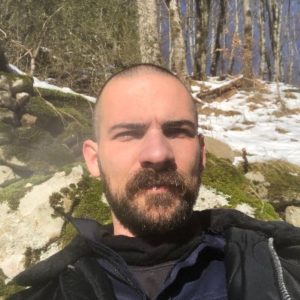
James W. Sanders is a cognitive neuroscientist and phenomenologist working with the Centre for Psychedelic Research at Imperial College London. His research concerns the scientific measurement and description of psychedelic experience, with a focus on micro-phenomenology, neurophenomenology, and psychedelic psychometrics. As a micro-phenomenologist in the DMT research group headed by Dr. Chris Timmermann, James works primarily with short acting tryptamines, notably 5-MeO-DMT, N,N-DMT, and extended state DMT. He is involved in the development of the micro-phenomenological analysis method for altered and non-ordinary states of consciousness, as well as the development of qualitative methods for systematic study of the meaning making and integration processes that surround those states.
Colloquium Presentation: 8 December 2023 – 3:30-5pm (in-person)
Title: Towards a micro-phenomenology of the intravenous DMT state
Introduction:
When administered in the lab, the 5-HT2A receptor agonist N, N-Dimethyltryptamine (DMT) radically alters the subjective character of experience. The effect is short-acting and intense, with experiences typically featuring radical alterations of the senses and sense of self, entry into an abstract or architectural space, and the perceived presence of sentient others. Scientific understanding of DMT experiences in a lab setting is limited by the shortcomings of commonly used phenomenological methods. Specifically, quantitative methods such as self-report questionnaires, and quantitative methods such as thematic analysis of semi-structured interviews, do not capture the temporal dynamics of the interviews, instead averaging properties over the entire experience. The micro-phenomenology (MP) interview and analysis method is well suited to address this lack of granularity in psychedelic phenomenology, modelling experience richly on both the synchronic (within-moment) and diachronic (between-moments) dimensions.
Methods:
20 participants were intravenously dosed with 20 mg of DMT fumarate in a lab setting, while undergoing combined EEG and fMRI. MP interviews about the experience were performed upon return to a baseline state. The MP analysis protocol was applied, including novel adaptations developed to accommodate the particularities of non-ordinary experience. Synchronic and diachronic categories were extracted and used to compare and cluster similar experiences.
Results:
Generic phenomenological structures were revealed concerning 1) the synchronic structure of the perceived presence of sentient others, showing the phenomenological distinctions that emerged in the descriptions and representing them in a hierarchical, semantic network 2) the diachronic, developmental structure of the complexity of the experience from beginning to end, showing the different phases of experience and the phenomenological distinctions that marked the division between phases.
Discussion:
The MP method was used to collect rich descriptions of the intravenous DMT experience, and formally represent the described phenomenology in a way that is compatible with neurophenomenological comparison to the concurrent fMRI/EEG data. This study represents the first step in a MP pipeline, and further research should further develop the granularity and generalisability of these results beyond experiences in the lab, and use these results in comparative phenomenological work with other non-ordinary experiences, especially those featuring the perceived presence of sentient others.